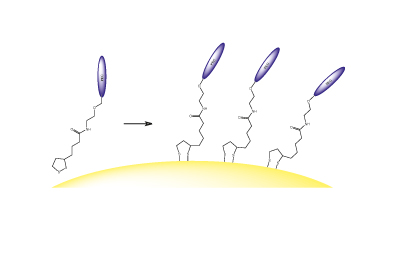Welcome to Iris Biotech
For better service please confirm your country and language we detected.

For better service please confirm your country and language we detected.

Thank you very much for your interest in our products. All prices listed on our website are ex-works, Germany, and may attract customs duties when imported.
You may/will be contacted by the shipping company for additional documentation that may be required by the US Customs for clearance.
We offer you the convenience of buying through a local partner, Peptide Solutions LLC who can import the shipment as well as prepay the customs duties and brokerage on your behalf and provide the convenience of a domestic sale.
Continue to Iris Biotech GmbHSend request to US distributorPublished on 07/02/2017
3.7 PEG-Thiols
3.7.1 Lipoamide-PEGs
Nanotechnology and nanobiotechnology using gold or silver particles, quantum dots or even magnetic particles are broadly diverse, rapidly expanding areas of study in medical diagnostics and therapeutics, sensoric and chemistry. Metal particles, however, are not water soluble without further modification. Thiols readily form dative bonds to gold and silver surfaces creating selfassembled monolayers (SAMs) which modify surfaces for coupling proteins and other molecules. Monothiols, however, can be readily removed by reducing agents such as DTT (Cleland’s Reagent). The disulfide lipoic acid (also known as thioctic acid) binds far stronger to metal surfaces and is much more resistant towards removal from the metal surface by DTT and similar reagents than monothiols. PEG linkers impart hydrophilicity, non-antigenicity and nonimmunogenicity to nanoparticles. With the methoxy-capped PEG linker a water shell can be created around the nanoparticle. Lipoamido-PEG-acids and lipoamido-PEG-alcohols can be used as intermediates for derivatizing the PEG linker after attaching to the surface. A co-coating with methoxy-PEG-lipoamides will specifically reduce the density of functional groups on the surface. This is essential if interaction with large molecules like proteins and antibodies is expected. Stench is often operative for thiols! Lipoic acid derivatives, however, have NO ODOR.

Protocol:
A variety of protocols exist in the literature and on various websites for reducing lipoic acid (LA) to dihydrolipoic acid (DHLA). Both Tris(2-carboxyethyl)phosphine (TCEP) and sodium borohydride (NaBH4) have been used successfully for reduction of LA to DHLA. For specific procedures, please consult literature. In general, TCEP reduction is carried out in water or aqueous buffer (excluding phosphate buffer, in which TCEP is unstable), in three times or greater molar excess to the lipoic acid derivative, using an incubation temperature of 25°C to 50°C, for about 1-2 hours. Each reduction procedure must be optimized for the particular lipoic acid derivative being reduced to the corresponding DHLA derivative.
References: